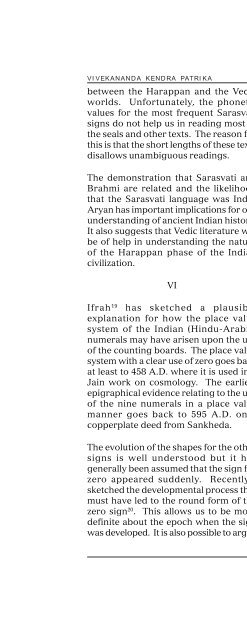Aryan Invasion Theory - Publication - Vivekananda Kendra
Aryan Invasion Theory - Publication - Vivekananda Kendra
Aryan Invasion Theory - Publication - Vivekananda Kendra
Create successful ePaper yourself
Turn your PDF publications into a flip-book with our unique Google optimized e-Paper software.
VIVEKANANDA KENDRA PATRIKA<br />
between the Harappan and the Vedic<br />
worlds. Unfortunately, the phonetic<br />
values for the most frequent Sarasvati<br />
signs do not help us in reading most of<br />
the seals and other texts. The reason for<br />
this is that the short lengths of these texts<br />
disallows unambiguous readings.<br />
The demonstration that Sarasvati and<br />
Brahmi are related and the likelihood<br />
that the Sarasvati language was Indo-<br />
<strong>Aryan</strong> has important implications for our<br />
understanding of ancient Indian history.<br />
It also suggests that Vedic literature will<br />
be of help in understanding the nature<br />
of the Harappan phase of the Indian<br />
civilization.<br />
VI<br />
Ifrah 19 has sketched a plausible<br />
explanation for how the place value<br />
system of the Indian (Hindu-Arabic)<br />
numerals may have arisen upon the use<br />
of the counting boards. The place value<br />
system with a clear use of zero goes back<br />
at least to 458 A.D. where it is used in a<br />
Jain work on cosmology. The earliest<br />
epigraphical evidence relating to the use<br />
of the nine numerals in a place value<br />
manner goes back to 595 A.D. on a<br />
copperplate deed from Sankheda.<br />
The evolution of the shapes for the other<br />
signs is well understood but it has<br />
generally been assumed that the sign for<br />
zero appeared suddenly. Recently I<br />
sketched the developmental process that<br />
must have led to the round form of the<br />
zero sign 20 . This allows us to be more<br />
definite about the epoch when the sign<br />
was developed. It is also possible to argue<br />
74<br />
ARYAN INVASION THEORY<br />
The Brahmi 10 before the advent of zero<br />
was written as a fish sign, or the sign<br />
form, lying sideways. In later forms it<br />
was also written as with a single curving<br />
stroke, or with vertical stroke attached<br />
to a circle. It appears that the shape of<br />
zero was determined by the oval related<br />
to the fish sign of the Brahmi 10. In such<br />
a representation, the zero sign clearly<br />
had the null (sunya) value which explains<br />
its name. We also see how the two<br />
concepts expressed by the Indian zero,<br />
namely those of the place value and that<br />
of nothing, are likely to have become<br />
self-evident. Perhaps the simultaneous<br />
existence of the two forms of expressing<br />
numbers helped in the development of<br />
the dual concepts associated with the<br />
zero sign.<br />
We encounter the vertical stroke<br />
attached to a circle form for 10 in the 1 st<br />
and 2 nd century A.D. Nasik inscriptions<br />
and in the 1 st and 3 rd century Andhra and<br />
Ksatrapa inscriptions. And the curved<br />
form is seen in the 4 th century<br />
Jaggayapeta and Pallava grants 21 .<br />
Therefore, it is conceivable that the<br />
development of the zero sign occurred<br />
in these epochs.<br />
But the above epochs do not provide a<br />
definite era for the discovery of the zero<br />
sign, since it is likely that the new usuage<br />
competed with the traditional number<br />
system for centuries. In fact one would<br />
expect that inscriptions and deed plates<br />
would tend to follow the older and more<br />
commonly known style for a long time.<br />
For a parallel consider Europe where it<br />
took the Indian numerals about five<br />
centuries after their first known<br />
appearance in the Codex Vigilanus in 976

















